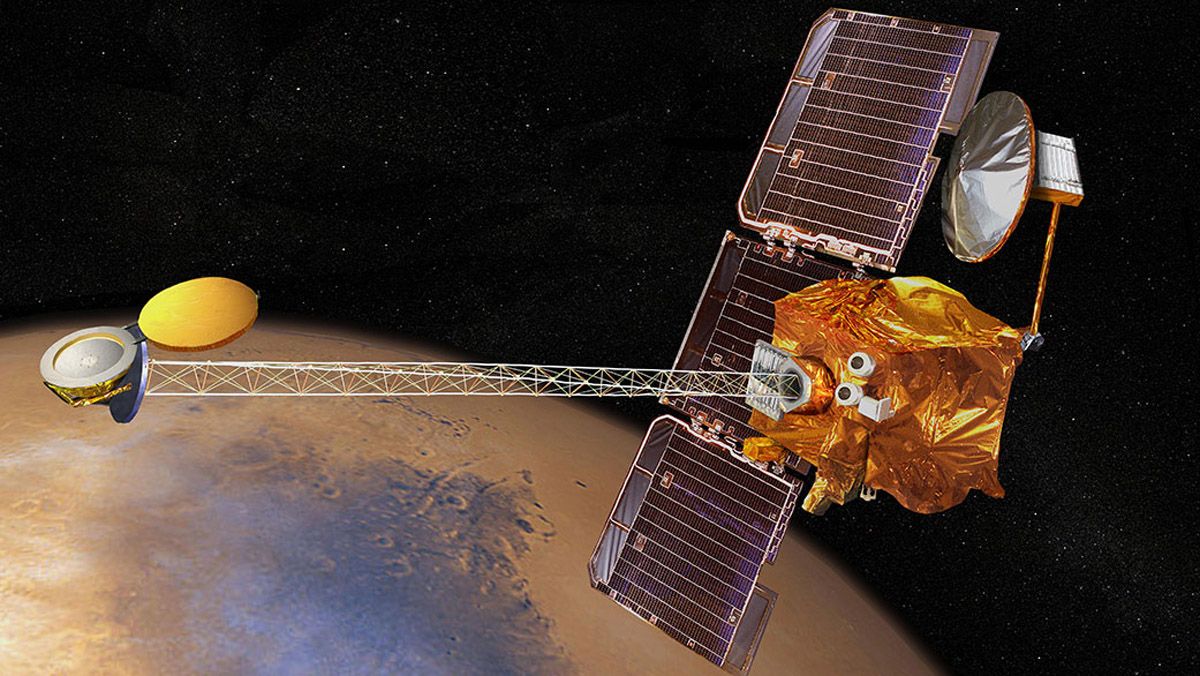Engineers at NASA and Lockheed Martin House have carried out the troublesome activity of measuring the gasoline provide of the oldest Mars orbiting spacecraft with out using a gasoline gauge, after calculations indicated the probe could also be near working on empty.
Estimates from 2021 and 2022 indicated the Mars Odyssey orbiter has exhausted its propellant a lot sooner than anticipated, prompting the investigation of the craft’s “lacking gasoline.” Finally, the scientists concluded that the lacking gasoline was by no means lacking in any respect! Which means Odyssey ought to have sufficient propellant to maintain going till the top of 2025.
The Mars Odyssey orbiter has been in house for 22 years. Throughout this time, the mission has accomplished over 94,000 orbits of Mars and delivered a wealth of spectacular discoveries such because the detection of water ice underneath the planet’s floor that could possibly be utilized by future astronauts.
Associated: The big reveal: What’s ahead in returning samples from Mars?
Throughout its mission, Odyssey has traveled the equal of 1.37 billion miles (2.21 billion kilometers) round Mars, which has required cautious gasoline administration. The issue is that the spacecraft, launched in 2001, is not fitted with a gasoline gauge.
Which means NASA operators should depend on arithmetic and ingenious checks to calculate how a lot of the five hundred kilos (225.3 kilograms) of hydrazine propellant the craft lifted off from Earth with is left.
The remaining gasoline provides are measured by making use of warmth to Odyssey’s two propellant tanks to see how rapidly they attain a set temperature, which signifies how stuffed with gasoline they’re. Identical to an empty teapot which heats up sooner than a full one, an empty gasoline tank ought to hit a goal temperature extra quickly than a full one, NASA said in a statement (opens in new tab).
In 2021, the take a look at indicated that Odyssey had simply 11 kilos (5 kg) of propellant left, which is lower than mathematical modeling of the probe’s gasoline consumption predicted. In January 2022, the NASA group used the tactic once more, and once more got here up with a decrease than anticipated quantity of remaining gasoline: simply 6 kilos (2.8 kg) of hydrazine. If the outcomes are appropriate, Odyssey could be working on empty in lower than a 12 months.
The engineers did not know methods to clarify the discrepancy between the take a look at outcomes and the expectations and got down to conduct a deeper investigation, which revealed hitherto unknown particulars about how the craft’s complicated gasoline system has aged whereas in flight.
So the place did Odyssey’s “lacking gasoline” go?
Following the calculations that indicated the Mars Odyssey Orbiter could also be working low on gasoline, NASA Jet Propulsion Laboratory (JPL) scientists drafted in Lockheed Martin House engineers, who not solely constructed Odyssey, but additionally preserve its mission operations and supply engineering assist for the craft.
“First, we needed to confirm the spacecraft was OK,” Odyssey’s venture supervisor at JPL, Joseph Hunt, mentioned within the assertion. “After ruling out the potential of a leak or that we had been burning extra gasoline than estimated, we began our measuring course of.”
The mixed JPL/Lockheed Martin House group determined that they wanted “contemporary eyes” to evaluate the Odyssey concern. These contemporary eyes got here within the type of spacecraft propellant estimation guide, Boris Yendler.
Yendler related the lacking gasoline to the truth that, like all spacecraft, Odyssey makes use of some gasoline to maintain its programs at optimum working temperatures and defend them from the chilly of house. The guide questioned if some supply on Odyssey was including warmth to its gasoline. This could have the impact of inflicting temperatures to rise sooner throughout the gasoline tank heating take a look at, thus giving inaccurate gasoline measurements.
The painstaking investigation led to the invention that heaters alongside an Odyssey gasoline line had been warming related propellant tanks, making them seem emptier than they really are. Accounting for this of their methodology of measurement and factoring in additional complicated fluid dynamics, the group was capable of decide that Odyssey has about 9 kilos (4 kg) of hydrazine left.
Mars Odyssey would not really burn by way of a lot gasoline every day, as photo voltaic panels on the craft provide the power wanted to energy its programs. Moreover, the probe makes use of response wheels to remain pointed towards Mars throughout science investigations. These wheels spin contained in the spacecraft’s physique, producing torque that permits Odyssey to keep up its perspective with out propellant.
The place the hydrazine really is available in is when Odyssey completes a full orbit and wishes to dump rising momentum in its response wheels. The spacecraft does this by releasing tiny exactly measured bursts of propellant by way of its thrusters.
Because of such restricted use Odyssey has sufficient gasoline left to final a couple of extra years at the least. The group, nevertheless, acknowledges that the remaining gasoline amount they calculated could change as they refine their calculations and enhance measurement accuracy. Nonetheless, the group is for certain that they now perceive the craft higher than they did beforehand.
“It is a bit of like our course of for scientific discovery,” Odyssey’s mission supervisor at NASA JPL, Jared Name, mentioned within the assertion. “You discover an engineering system not understanding what you may discover. And the longer you look, the extra you discover what you did not count on.”
Comply with us on Twitter @Spacedotcom (opens in new tab) or on Facebook (opens in new tab).


